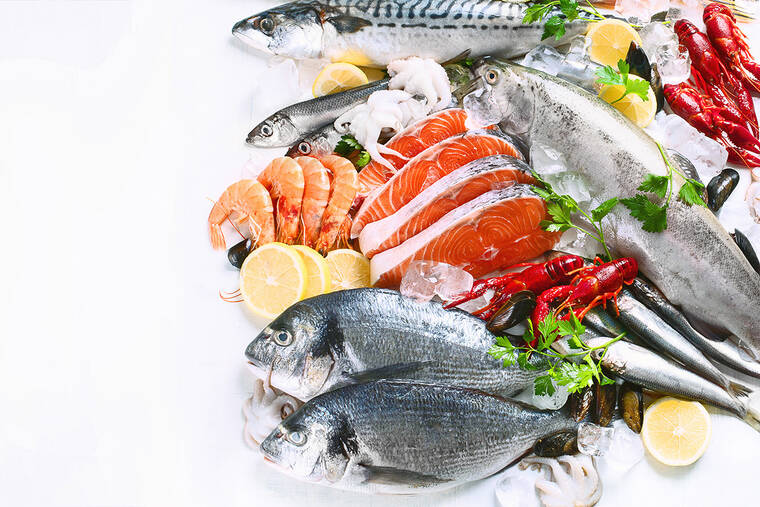‘Sea’ the individual – West Hawaii Today
‘Sea’ the individual West Hawaii Today


October is National Seafood Month: A Report on the Unsustainability of the Seafood Industry

The consumption of fish and other aquatic animals is fueling an environmental catastrophe. Seafood is unsustainable.
The Impact on Whales and Dolphins
In the 1970s and ’80s, “Save the Whales” became an inescapable campaign catchphrase. A tidal wave of activism secured an international ban on commercial whaling. But whales are still in grave danger — due to fishing. Nearly half the plastic in the Great Pacific Garbage Patch comes from discarded fishing equipment. Over 300,000 whales and dolphins die each year after being injured by fishing nets or lines. In many cases, these victims spend their last moments desperately struggling to free themselves until they die from exhaustion, starvation, suffocation, strangulation, or dismemberment. Recent studies show that more than half the members of some whale species have been caught in fishing gear. Even when they’re lucky enough to escape death, their injuries are often permanent, and females who survive entanglement have much lower birth rates.
The Fascinating Lives of Aquatic Mammals
Aquatic mammals are fascinating individuals. Whales and dolphins have close-knit family structures and often communicate with one another through song. They’re devoted mothers, spending as much time as possible with their young. And just like humans, they grieve the loss of their loved ones, sometimes carrying a deceased baby for weeks.
The Intelligence and Sentience of Fish and Crustaceans
The fish and crustaceans so callously disregarded as “food” are sensitive, intelligent animals, too. Fish can count and tell time, think ahead, and “talk” to one another. Lobsters are also complex individuals, and they use sophisticated signals to explore their surroundings and establish social relationships. Octopuses, like other animals, including humans, experience joy, excitement, boredom, and fear. Keenly smart and self-aware, they have been known to use seashells for protection, steal food from traps set by fishers, escape from aquariums, and even decorate their homes. And just like humans, these animals all have the capacity to feel pain.
The Cruelty and Environmental Impact of the Seafood Industry
Yet the cruel seafood industry inflicts horrific suffering on aquatic animals while contributing to the decimation of aquatic ecosystems. The profit-driven fish-farming business confines its victims to cramped facilities riddled with parasites and disease. Giant “net pens” pollute surrounding waters with antibiotics and chemicals. And despite what the industry and fishers might claim, “traditional” fishing is destructive, too. The U.S. Environmental Protection Agency reports that recreational boaters cause damage to lakes, coastal waters, and rivers by increasing pollutant concentrations, erosion rates, and levels of aquatic pathogens. An estimated 90% of large-fish populations have been wiped out — and many of those fish don’t even end up on a dinner plate, because the fishing industry discards more fish than it keeps. In April, a federal panel approved a temporary salmon fishing ban for much of the West Coast of the U.S. due to an alarming population decline.
The Unsustainability of Seafood and its Impact on Human Health
Something that’s sustainable is part of a thriving, healthy ecosystem, and such ecosystems don’t have adverse effects on human health. The seafood industry fails on both counts. One investigation found unpredictable levels of mercury — which can cause impaired brain function in children — in five popular brands of canned tuna and suggests that pregnant women avoid it altogether. But the danger extends to everyone. Another study found that eating just a single fish pulled from a U.S. lake or river could be equivalent to drinking water tainted with dangerous chemicals for a month.
The Rise of Vegan Seafood
Fortunately, consumers don’t have to forgo the taste of seafood. With demand comes supply, and the vegan seafood industry is booming. Cruelty-free brands offer delicious fishless fillets, tuna-free tuna, crab cakes made from plants, and so much more. Turn October into National “Sea for Yourself Month” and give these treats a try.
SDGs, Targets, and Indicators Analysis
1. Which SDGs are addressed or connected to the issues highlighted in the article?
- SDG 14: Life Below Water – The article discusses the negative impact of the seafood industry on aquatic ecosystems, including the decimation of fish populations and the pollution of surrounding waters.
- SDG 15: Life on Land – The article mentions the harm caused to whales and dolphins due to fishing, as well as the damage caused by recreational boaters to lakes, coastal waters, and rivers.
2. What specific targets under those SDGs can be identified based on the article’s content?
- SDG 14.4: By 2020, effectively regulate harvesting and end overfishing, illegal, unreported, and unregulated (IUU) fishing, and destructive fishing practices – The article highlights the destructive nature of the fishing industry and the need to regulate fishing practices to protect aquatic ecosystems.
- SDG 15.1: By 2020, ensure the conservation, restoration, and sustainable use of terrestrial and inland freshwater ecosystems and their services, in particular forests, wetlands, mountains, and drylands, in line with obligations under international agreements – The article emphasizes the need for sustainable practices in the seafood industry to protect aquatic ecosystems.
3. Are there any indicators mentioned or implied in the article that can be used to measure progress towards the identified targets?
- Indicator for SDG 14.4: Proportion of fish stocks within biologically sustainable levels – The article mentions that an estimated 90% of large-fish populations have been wiped out, indicating the need to measure and monitor fish stocks to ensure their sustainability.
- Indicator for SDG 15.1: Proportion of important sites for terrestrial and freshwater biodiversity that are covered by protected areas, by ecosystem type – The article discusses the damage caused to aquatic ecosystems by fishing and recreational boating, highlighting the importance of protecting these areas to ensure their conservation and restoration.
SDGs, Targets, and Indicators Table
| SDGs | Targets | Indicators |
|---|---|---|
| SDG 14: Life Below Water | 14.4: By 2020, effectively regulate harvesting and end overfishing, illegal, unreported, and unregulated (IUU) fishing, and destructive fishing practices | Proportion of fish stocks within biologically sustainable levels |
| SDG 15: Life on Land | 15.1: By 2020, ensure the conservation, restoration, and sustainable use of terrestrial and inland freshwater ecosystems and their services, in particular forests, wetlands, mountains, and drylands, in line with obligations under international agreements | Proportion of important sites for terrestrial and freshwater biodiversity that are covered by protected areas, by ecosystem type |
Behold! This splendid article springs forth from the wellspring of knowledge, shaped by a wondrous proprietary AI technology that delved into a vast ocean of data, illuminating the path towards the Sustainable Development Goals. Remember that all rights are reserved by SDG Investors LLC, empowering us to champion progress together.
Source: westhawaiitoday.com

Join us, as fellow seekers of change, on a transformative journey at https://sdgtalks.ai/welcome, where you can become a member and actively contribute to shaping a brighter future.







